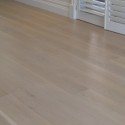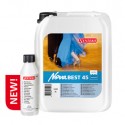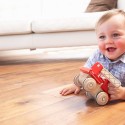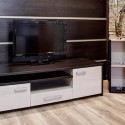The warm summer months in Australia are a joyous time for some, but not for floor sanders. The warm to hot Australian climate brings on a host of coating and finish problems. Therefore, it is important for the applicator to be aware of these common problems and the necessary course of action he must undertake to deliver a quality floor finish.
When temperature reaches 24C, coatings start to become difficult to work with and apply. When temperature exceeds this figure, especially on a day to day base, this will have an even greater negative affect on the application of the coating.
If one reads any coating manufactures technical data sheet’s there will always be a reference to the maximum and minimum temperature that one can successfully apply the floor finish. Obviously coating in conditions where the temperature exceeds these parameters will make the coating unworkable and troublesome. Further, one must not forget that in the warm to hot summer months the building structure and especially the timber floor will absorb and retain heat for lengthy periods. When one coats a floor in this ’ hot house’ type environment the floor finish will dry faster than normal, as it absorbs the radiant heat of the floor and surrounding structure.
An important element of the coating that is influenced by high temperatures is the increase rate of drying and curing. This results in a loss of “wet edge”, making any coating more difficult to work with. In addition, water based floor finishes are extremely temperamental and less forgiving in warmer conditions.
The problems that occur in summer for solvent based, water based and to a lesser extent oil type finishes are:
Viscosity increases: this means that the coating will become thicker to apply as the solvents flash off faster. This will result in poor flow and levelling causing:
- Orange peel
- Thickening of the coating especially two component products and solidification resulting in small gel particles.
- Poor levelling and flow characteristics
- Application marks from the roller overlapping on sides and where it stops as the finish dries Brush marks around perimeter of room, commonly known as “picture framing”.
- Air bubbles from the roller are trapped into the coat on the surface and do not burst in time as the top film of the coating dries
- Inconsistent sheen
- Reduced working time because of the loss of the wet edge
Solar gain: Sunlight beating down on the timber floor, through windows, will heat it up to temperatures far exceeding the air temperature. If the floor is dark because it has been stained or a dark colour timber the floor temperature will be even greater. When the coating is applied to a hot floor:
- It “sets up” quickly, drying too fast
- Coating can blister
- Coating will not penetrate and bond properly to the timber, as it dries too quickly, causing it to delaminate later.
- Application problems of coating
Storage: Do not use warm finishes on colder floors. When coatings are kept in the vehicles or stored in sunny conditions the coating will not flow and level correctly. The result:
- When applying a warm water base coating on a colder surface, small fine bubbles will be trapped in the drying film of the coat as the air in the wood is warmed up.
- Shelf life of coating will be compromised as well as performance.
- When water base coatings are warmed up the defoamer additive will be affected resulting in increase in bubbles, poor levelling and inadequate flow
In summer in order to avoid the problems discussed above one needs to focus one factors that will reduce the incidence of problems:
- Keep the interior of the house and/or room cool for lengthy periods and avoid heat build-up over the hot days by ventilation and if possible running the air conditioning for lengthy period prior to commence coating. Do not run the air conditioning while coating.
- Cover the windows and doors with an opaque material to avoid sunlight heating up the floor area, a number of days prior to coating.
- Coat in the cooler part of the day such as early in the morning before sun heats up the floor area.
- Avoid air flow while coating by keeping windows closed. However once coating tacked off ventilate are to facilitate curing.
- Do not apply too thin a coat. With some finishes a thicker coat will keep the wet edge longer.
- Acclimatise coating before it is applied. Do not store coating in vehicle at any time. Never apply a coating that is warmer than the floor.
- Always store water base finishes in a cool place and during transport store a ‘cold box’.




